Rewards as a Motivational Tool: Research Project Proposal
VerifiedAdded on 2022/11/14
|30
|7417
|173
Project
AI Summary
This research project proposal investigates the role of rewards as a motivational tool within organizations. The proposal begins with an introduction to the topic, highlighting the importance of motivation in the modern business environment and the impact of globalization. It outlines the research aims, objectives, and research questions, focusing on the effectiveness of rewards in motivating employees. The literature review examines early approaches to motivation, the relationship between rewards and employee performance, and relevant motivational theories. The methodology section details the research design, including qualitative interviews, sampling, ethical considerations, and the project's budget, resources, and timeline. The proposal also includes a team charter and communication strategy, along with appendices containing figures and tables. The project aims to determine the types of rewards that attract employees and the issues managers face when implementing motivational theories. The research will provide valuable insights into how organizations can effectively use rewards to enhance employee engagement and improve overall performance.
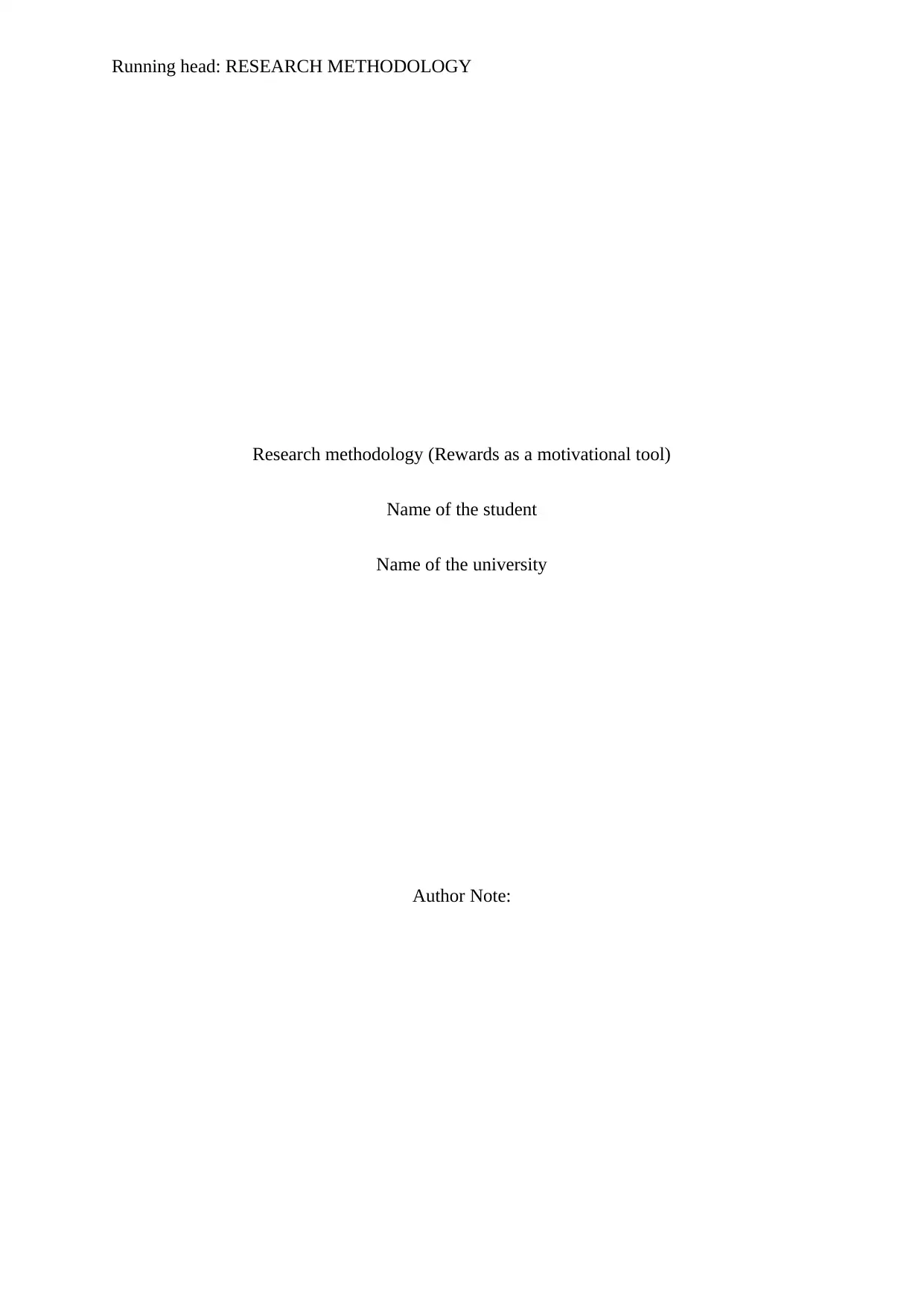
Running head: RESEARCH METHODOLOGY
Research methodology (Rewards as a motivational tool)
Name of the student
Name of the university
Author Note:
Research methodology (Rewards as a motivational tool)
Name of the student
Name of the university
Author Note:
Paraphrase This Document
Need a fresh take? Get an instant paraphrase of this document with our AI Paraphraser
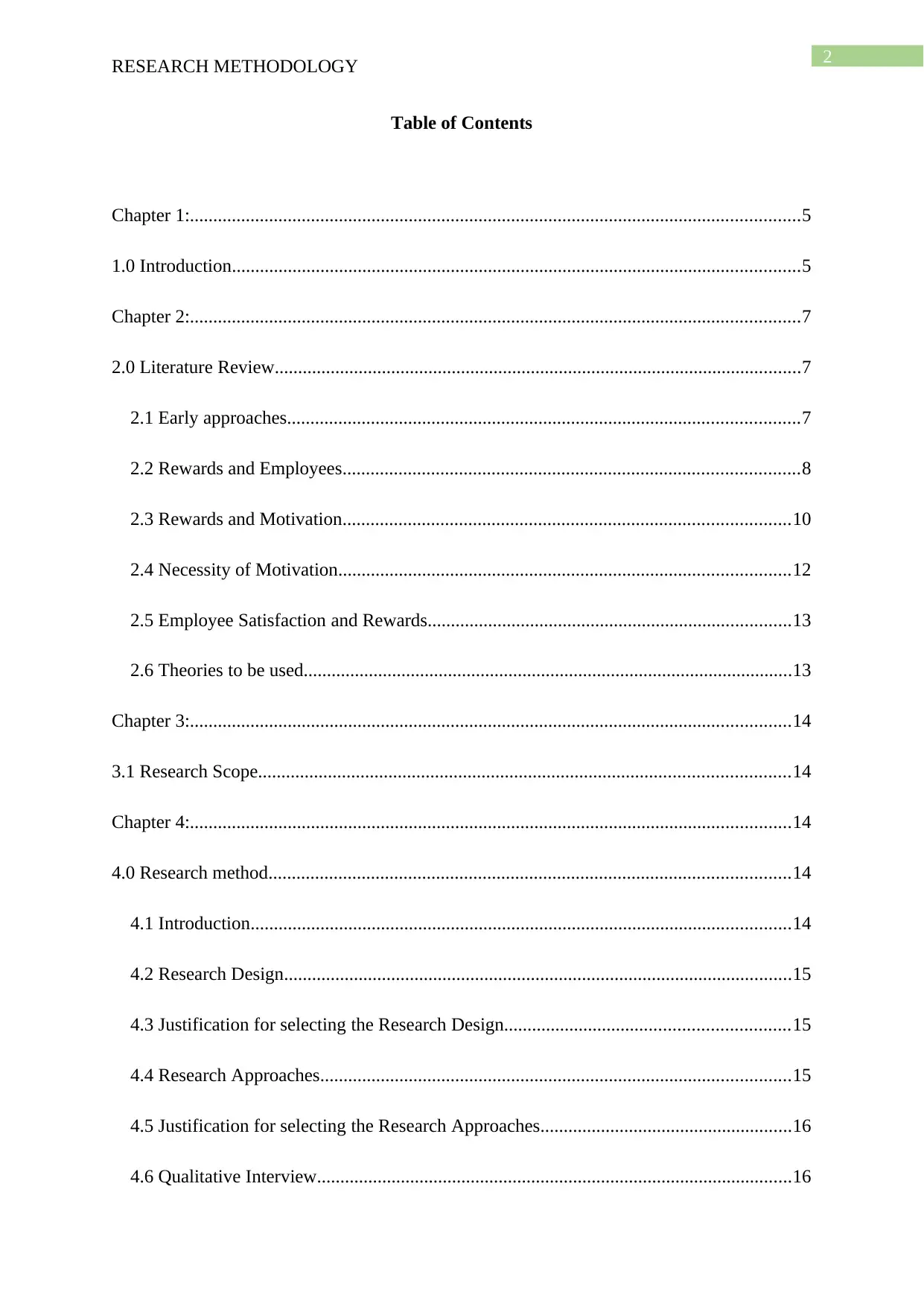
2
RESEARCH METHODOLOGY
Table of Contents
Chapter 1:...................................................................................................................................5
1.0 Introduction..........................................................................................................................5
Chapter 2:...................................................................................................................................7
2.0 Literature Review.................................................................................................................7
2.1 Early approaches..............................................................................................................7
2.2 Rewards and Employees..................................................................................................8
2.3 Rewards and Motivation................................................................................................10
2.4 Necessity of Motivation.................................................................................................12
2.5 Employee Satisfaction and Rewards..............................................................................13
2.6 Theories to be used.........................................................................................................13
Chapter 3:.................................................................................................................................14
3.1 Research Scope..................................................................................................................14
Chapter 4:.................................................................................................................................14
4.0 Research method................................................................................................................14
4.1 Introduction....................................................................................................................14
4.2 Research Design.............................................................................................................15
4.3 Justification for selecting the Research Design.............................................................15
4.4 Research Approaches.....................................................................................................15
4.5 Justification for selecting the Research Approaches......................................................16
4.6 Qualitative Interview......................................................................................................16
RESEARCH METHODOLOGY
Table of Contents
Chapter 1:...................................................................................................................................5
1.0 Introduction..........................................................................................................................5
Chapter 2:...................................................................................................................................7
2.0 Literature Review.................................................................................................................7
2.1 Early approaches..............................................................................................................7
2.2 Rewards and Employees..................................................................................................8
2.3 Rewards and Motivation................................................................................................10
2.4 Necessity of Motivation.................................................................................................12
2.5 Employee Satisfaction and Rewards..............................................................................13
2.6 Theories to be used.........................................................................................................13
Chapter 3:.................................................................................................................................14
3.1 Research Scope..................................................................................................................14
Chapter 4:.................................................................................................................................14
4.0 Research method................................................................................................................14
4.1 Introduction....................................................................................................................14
4.2 Research Design.............................................................................................................15
4.3 Justification for selecting the Research Design.............................................................15
4.4 Research Approaches.....................................................................................................15
4.5 Justification for selecting the Research Approaches......................................................16
4.6 Qualitative Interview......................................................................................................16
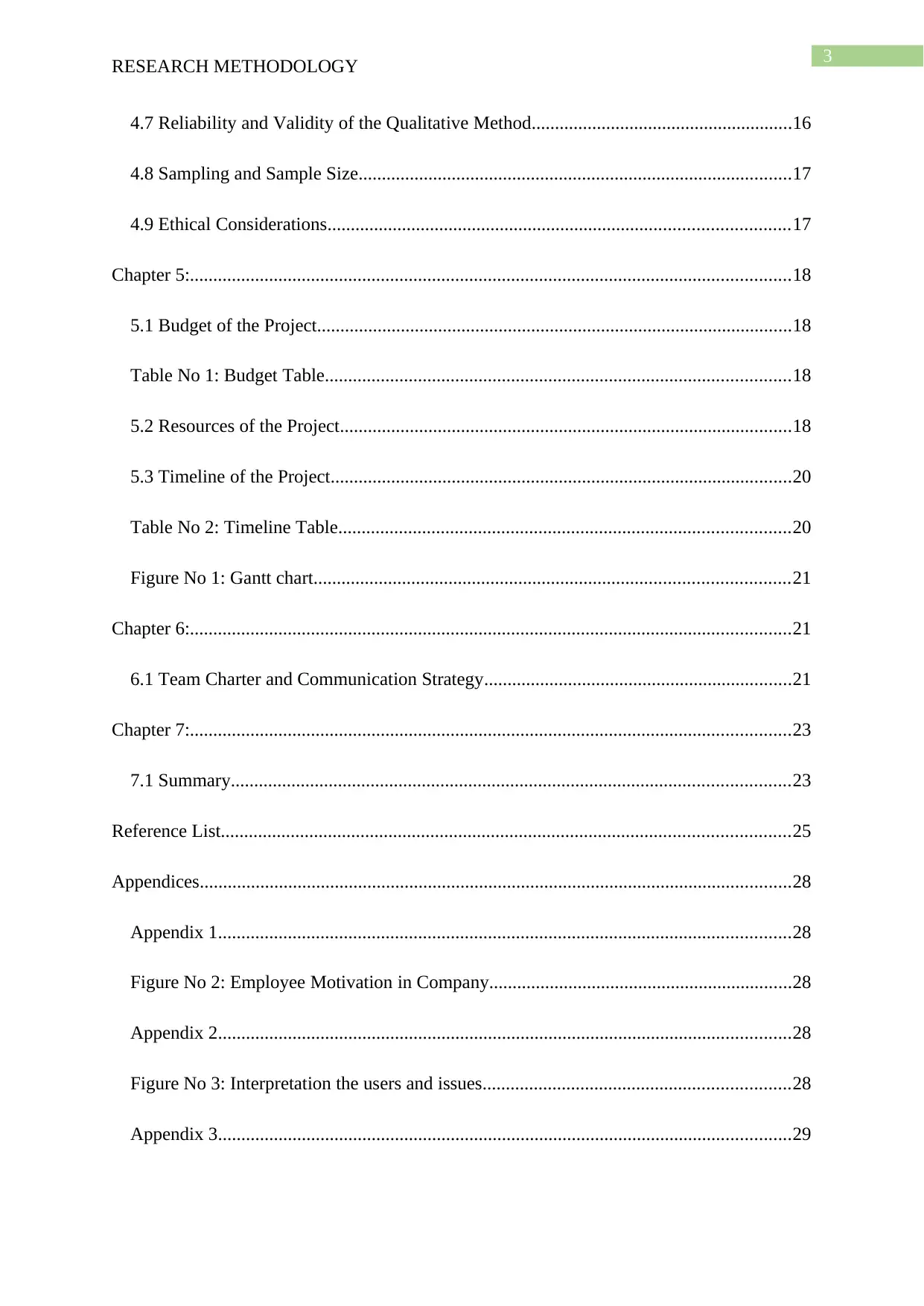
3
RESEARCH METHODOLOGY
4.7 Reliability and Validity of the Qualitative Method........................................................16
4.8 Sampling and Sample Size.............................................................................................17
4.9 Ethical Considerations...................................................................................................17
Chapter 5:.................................................................................................................................18
5.1 Budget of the Project......................................................................................................18
Table No 1: Budget Table....................................................................................................18
5.2 Resources of the Project.................................................................................................18
5.3 Timeline of the Project...................................................................................................20
Table No 2: Timeline Table.................................................................................................20
Figure No 1: Gantt chart......................................................................................................21
Chapter 6:.................................................................................................................................21
6.1 Team Charter and Communication Strategy..................................................................21
Chapter 7:.................................................................................................................................23
7.1 Summary........................................................................................................................23
Reference List..........................................................................................................................25
Appendices...............................................................................................................................28
Appendix 1...........................................................................................................................28
Figure No 2: Employee Motivation in Company.................................................................28
Appendix 2...........................................................................................................................28
Figure No 3: Interpretation the users and issues..................................................................28
Appendix 3...........................................................................................................................29
RESEARCH METHODOLOGY
4.7 Reliability and Validity of the Qualitative Method........................................................16
4.8 Sampling and Sample Size.............................................................................................17
4.9 Ethical Considerations...................................................................................................17
Chapter 5:.................................................................................................................................18
5.1 Budget of the Project......................................................................................................18
Table No 1: Budget Table....................................................................................................18
5.2 Resources of the Project.................................................................................................18
5.3 Timeline of the Project...................................................................................................20
Table No 2: Timeline Table.................................................................................................20
Figure No 1: Gantt chart......................................................................................................21
Chapter 6:.................................................................................................................................21
6.1 Team Charter and Communication Strategy..................................................................21
Chapter 7:.................................................................................................................................23
7.1 Summary........................................................................................................................23
Reference List..........................................................................................................................25
Appendices...............................................................................................................................28
Appendix 1...........................................................................................................................28
Figure No 2: Employee Motivation in Company.................................................................28
Appendix 2...........................................................................................................................28
Figure No 3: Interpretation the users and issues..................................................................28
Appendix 3...........................................................................................................................29
⊘ This is a preview!⊘
Do you want full access?
Subscribe today to unlock all pages.

Trusted by 1+ million students worldwide
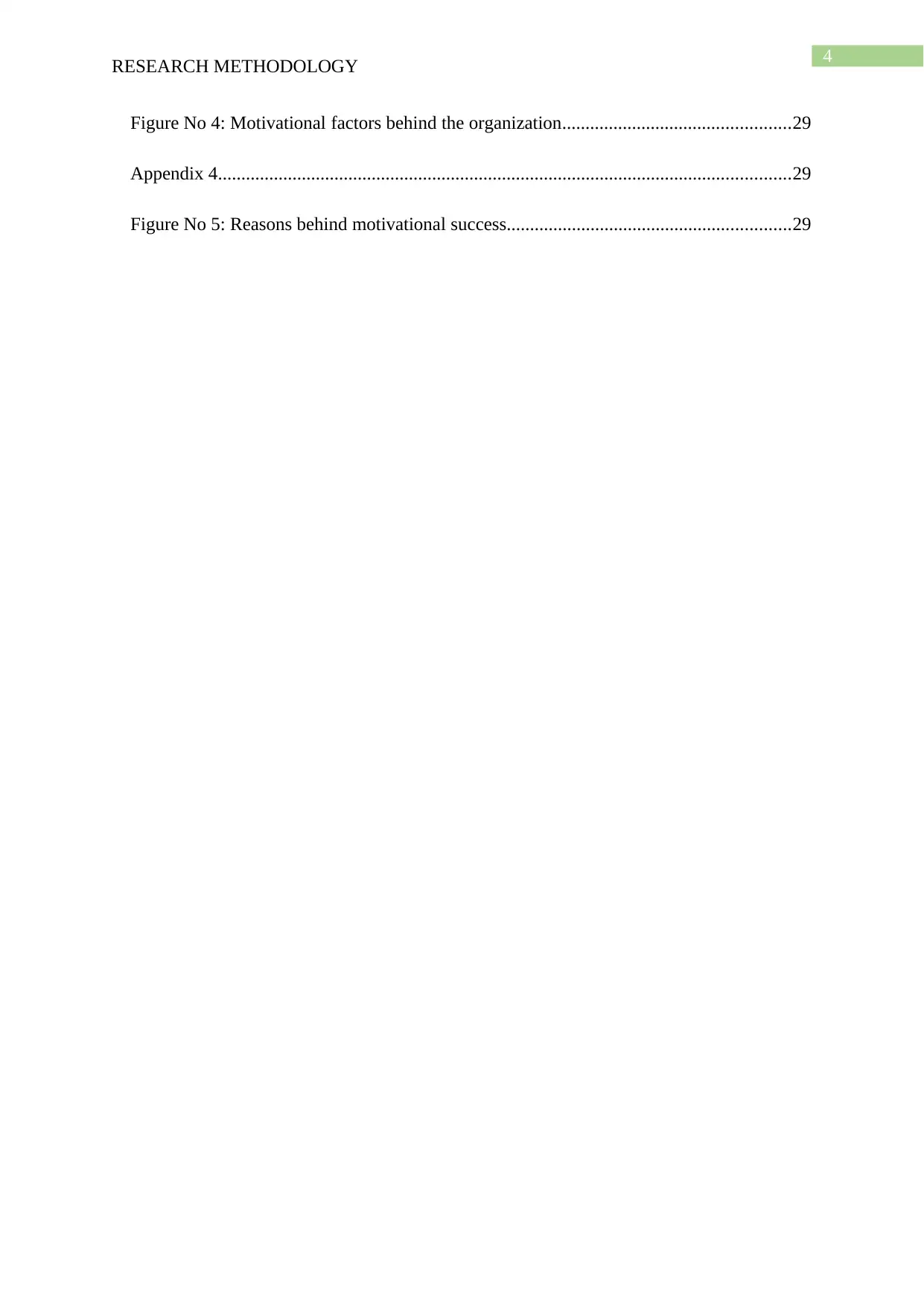
4
RESEARCH METHODOLOGY
Figure No 4: Motivational factors behind the organization.................................................29
Appendix 4...........................................................................................................................29
Figure No 5: Reasons behind motivational success.............................................................29
RESEARCH METHODOLOGY
Figure No 4: Motivational factors behind the organization.................................................29
Appendix 4...........................................................................................................................29
Figure No 5: Reasons behind motivational success.............................................................29
Paraphrase This Document
Need a fresh take? Get an instant paraphrase of this document with our AI Paraphraser
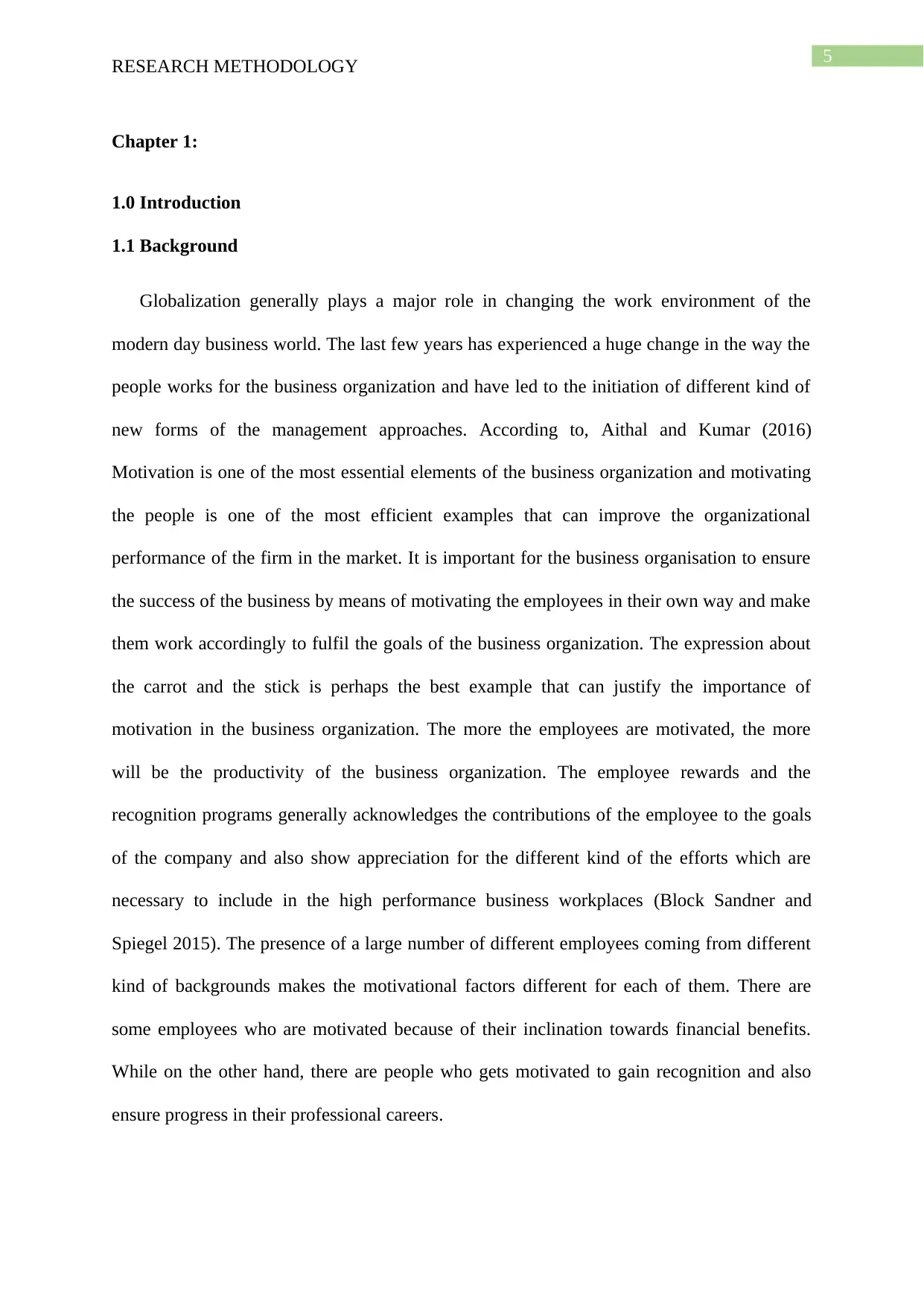
5
RESEARCH METHODOLOGY
Chapter 1:
1.0 Introduction
1.1 Background
Globalization generally plays a major role in changing the work environment of the
modern day business world. The last few years has experienced a huge change in the way the
people works for the business organization and have led to the initiation of different kind of
new forms of the management approaches. According to, Aithal and Kumar (2016)
Motivation is one of the most essential elements of the business organization and motivating
the people is one of the most efficient examples that can improve the organizational
performance of the firm in the market. It is important for the business organisation to ensure
the success of the business by means of motivating the employees in their own way and make
them work accordingly to fulfil the goals of the business organization. The expression about
the carrot and the stick is perhaps the best example that can justify the importance of
motivation in the business organization. The more the employees are motivated, the more
will be the productivity of the business organization. The employee rewards and the
recognition programs generally acknowledges the contributions of the employee to the goals
of the company and also show appreciation for the different kind of the efforts which are
necessary to include in the high performance business workplaces (Block Sandner and
Spiegel 2015). The presence of a large number of different employees coming from different
kind of backgrounds makes the motivational factors different for each of them. There are
some employees who are motivated because of their inclination towards financial benefits.
While on the other hand, there are people who gets motivated to gain recognition and also
ensure progress in their professional careers.
RESEARCH METHODOLOGY
Chapter 1:
1.0 Introduction
1.1 Background
Globalization generally plays a major role in changing the work environment of the
modern day business world. The last few years has experienced a huge change in the way the
people works for the business organization and have led to the initiation of different kind of
new forms of the management approaches. According to, Aithal and Kumar (2016)
Motivation is one of the most essential elements of the business organization and motivating
the people is one of the most efficient examples that can improve the organizational
performance of the firm in the market. It is important for the business organisation to ensure
the success of the business by means of motivating the employees in their own way and make
them work accordingly to fulfil the goals of the business organization. The expression about
the carrot and the stick is perhaps the best example that can justify the importance of
motivation in the business organization. The more the employees are motivated, the more
will be the productivity of the business organization. The employee rewards and the
recognition programs generally acknowledges the contributions of the employee to the goals
of the company and also show appreciation for the different kind of the efforts which are
necessary to include in the high performance business workplaces (Block Sandner and
Spiegel 2015). The presence of a large number of different employees coming from different
kind of backgrounds makes the motivational factors different for each of them. There are
some employees who are motivated because of their inclination towards financial benefits.
While on the other hand, there are people who gets motivated to gain recognition and also
ensure progress in their professional careers.
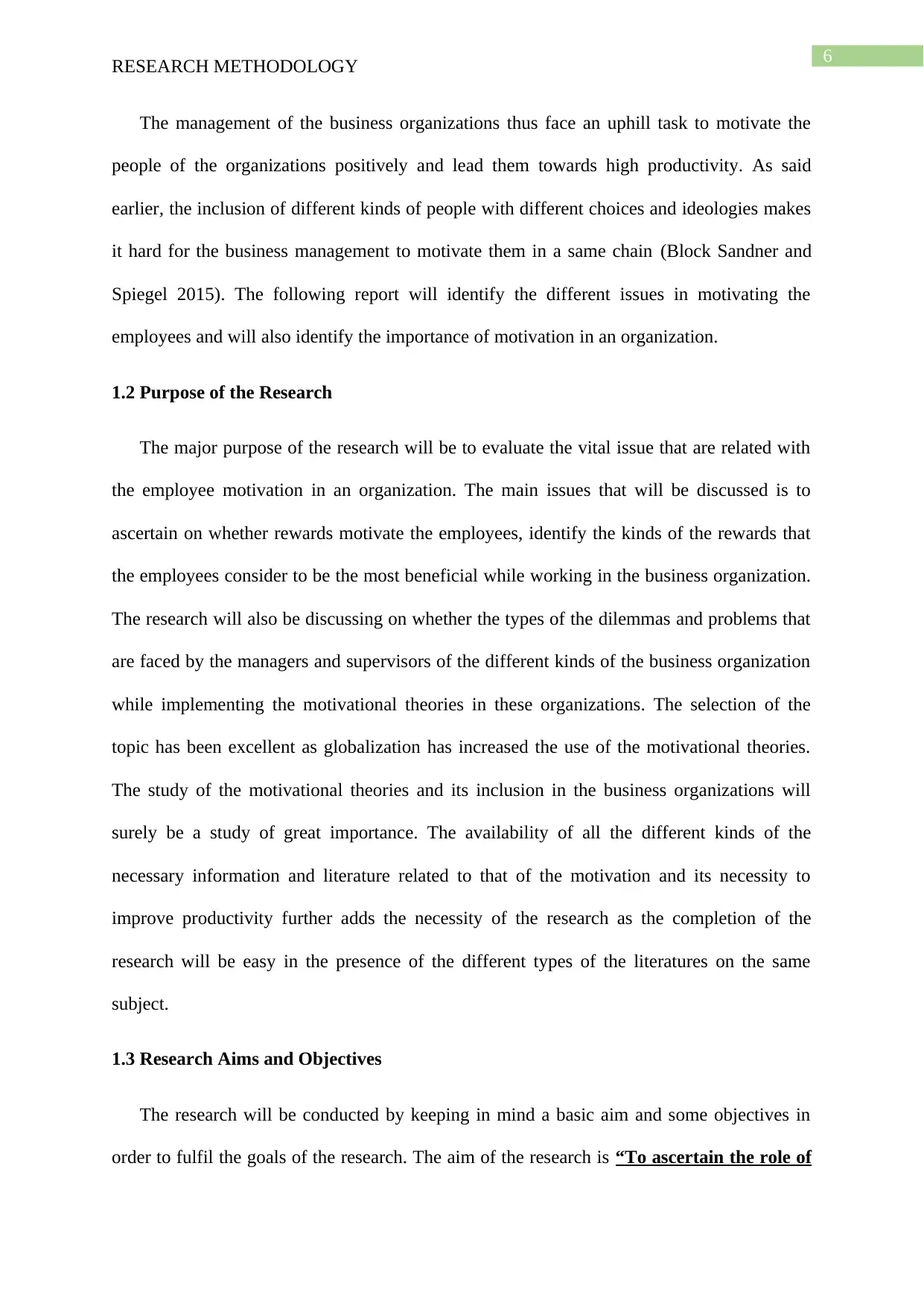
6
RESEARCH METHODOLOGY
The management of the business organizations thus face an uphill task to motivate the
people of the organizations positively and lead them towards high productivity. As said
earlier, the inclusion of different kinds of people with different choices and ideologies makes
it hard for the business management to motivate them in a same chain (Block Sandner and
Spiegel 2015). The following report will identify the different issues in motivating the
employees and will also identify the importance of motivation in an organization.
1.2 Purpose of the Research
The major purpose of the research will be to evaluate the vital issue that are related with
the employee motivation in an organization. The main issues that will be discussed is to
ascertain on whether rewards motivate the employees, identify the kinds of the rewards that
the employees consider to be the most beneficial while working in the business organization.
The research will also be discussing on whether the types of the dilemmas and problems that
are faced by the managers and supervisors of the different kinds of the business organization
while implementing the motivational theories in these organizations. The selection of the
topic has been excellent as globalization has increased the use of the motivational theories.
The study of the motivational theories and its inclusion in the business organizations will
surely be a study of great importance. The availability of all the different kinds of the
necessary information and literature related to that of the motivation and its necessity to
improve productivity further adds the necessity of the research as the completion of the
research will be easy in the presence of the different types of the literatures on the same
subject.
1.3 Research Aims and Objectives
The research will be conducted by keeping in mind a basic aim and some objectives in
order to fulfil the goals of the research. The aim of the research is “To ascertain the role of
RESEARCH METHODOLOGY
The management of the business organizations thus face an uphill task to motivate the
people of the organizations positively and lead them towards high productivity. As said
earlier, the inclusion of different kinds of people with different choices and ideologies makes
it hard for the business management to motivate them in a same chain (Block Sandner and
Spiegel 2015). The following report will identify the different issues in motivating the
employees and will also identify the importance of motivation in an organization.
1.2 Purpose of the Research
The major purpose of the research will be to evaluate the vital issue that are related with
the employee motivation in an organization. The main issues that will be discussed is to
ascertain on whether rewards motivate the employees, identify the kinds of the rewards that
the employees consider to be the most beneficial while working in the business organization.
The research will also be discussing on whether the types of the dilemmas and problems that
are faced by the managers and supervisors of the different kinds of the business organization
while implementing the motivational theories in these organizations. The selection of the
topic has been excellent as globalization has increased the use of the motivational theories.
The study of the motivational theories and its inclusion in the business organizations will
surely be a study of great importance. The availability of all the different kinds of the
necessary information and literature related to that of the motivation and its necessity to
improve productivity further adds the necessity of the research as the completion of the
research will be easy in the presence of the different types of the literatures on the same
subject.
1.3 Research Aims and Objectives
The research will be conducted by keeping in mind a basic aim and some objectives in
order to fulfil the goals of the research. The aim of the research is “To ascertain the role of
⊘ This is a preview!⊘
Do you want full access?
Subscribe today to unlock all pages.

Trusted by 1+ million students worldwide
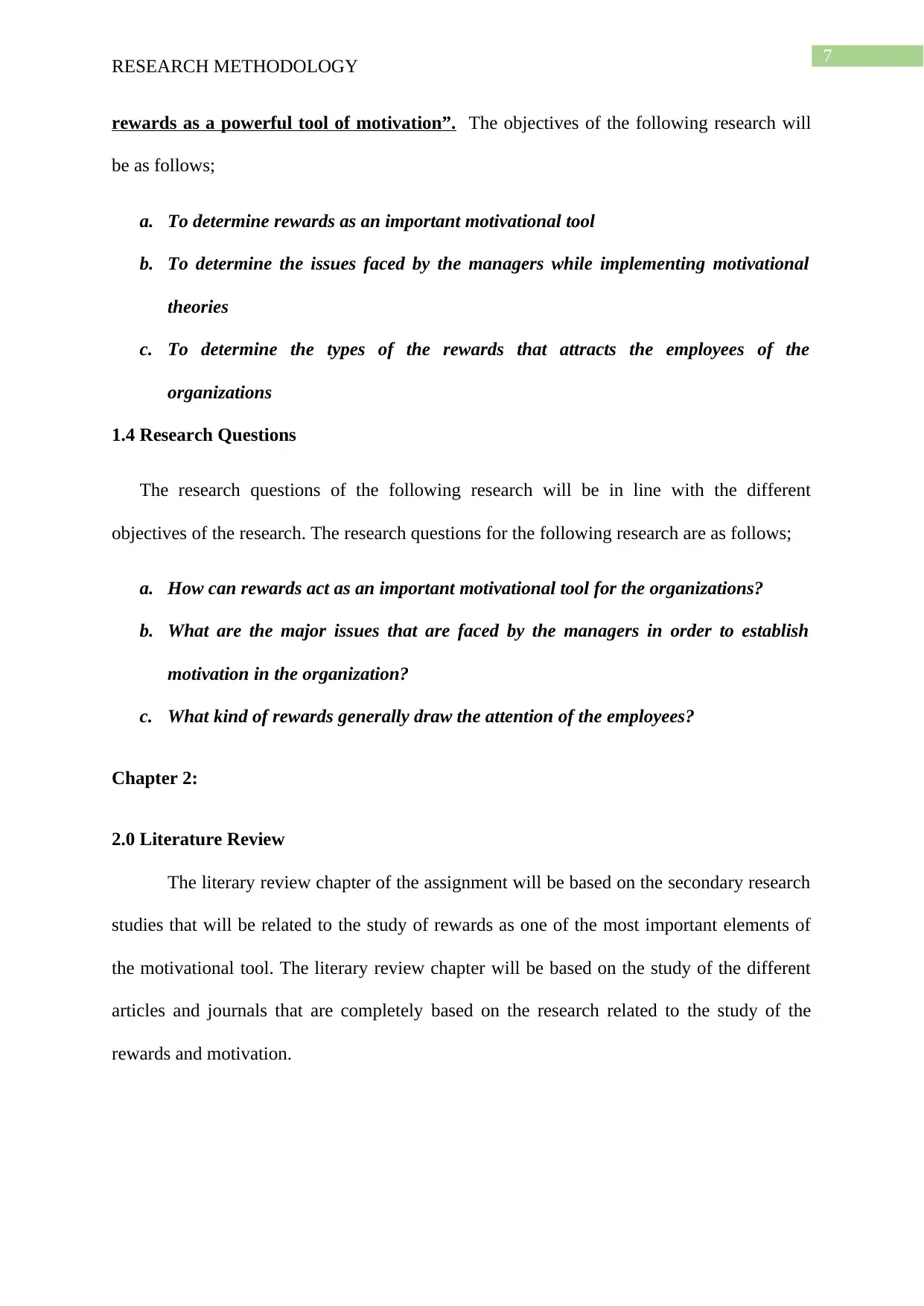
7
RESEARCH METHODOLOGY
rewards as a powerful tool of motivation”. The objectives of the following research will
be as follows;
a. To determine rewards as an important motivational tool
b. To determine the issues faced by the managers while implementing motivational
theories
c. To determine the types of the rewards that attracts the employees of the
organizations
1.4 Research Questions
The research questions of the following research will be in line with the different
objectives of the research. The research questions for the following research are as follows;
a. How can rewards act as an important motivational tool for the organizations?
b. What are the major issues that are faced by the managers in order to establish
motivation in the organization?
c. What kind of rewards generally draw the attention of the employees?
Chapter 2:
2.0 Literature Review
The literary review chapter of the assignment will be based on the secondary research
studies that will be related to the study of rewards as one of the most important elements of
the motivational tool. The literary review chapter will be based on the study of the different
articles and journals that are completely based on the research related to the study of the
rewards and motivation.
RESEARCH METHODOLOGY
rewards as a powerful tool of motivation”. The objectives of the following research will
be as follows;
a. To determine rewards as an important motivational tool
b. To determine the issues faced by the managers while implementing motivational
theories
c. To determine the types of the rewards that attracts the employees of the
organizations
1.4 Research Questions
The research questions of the following research will be in line with the different
objectives of the research. The research questions for the following research are as follows;
a. How can rewards act as an important motivational tool for the organizations?
b. What are the major issues that are faced by the managers in order to establish
motivation in the organization?
c. What kind of rewards generally draw the attention of the employees?
Chapter 2:
2.0 Literature Review
The literary review chapter of the assignment will be based on the secondary research
studies that will be related to the study of rewards as one of the most important elements of
the motivational tool. The literary review chapter will be based on the study of the different
articles and journals that are completely based on the research related to the study of the
rewards and motivation.
Paraphrase This Document
Need a fresh take? Get an instant paraphrase of this document with our AI Paraphraser
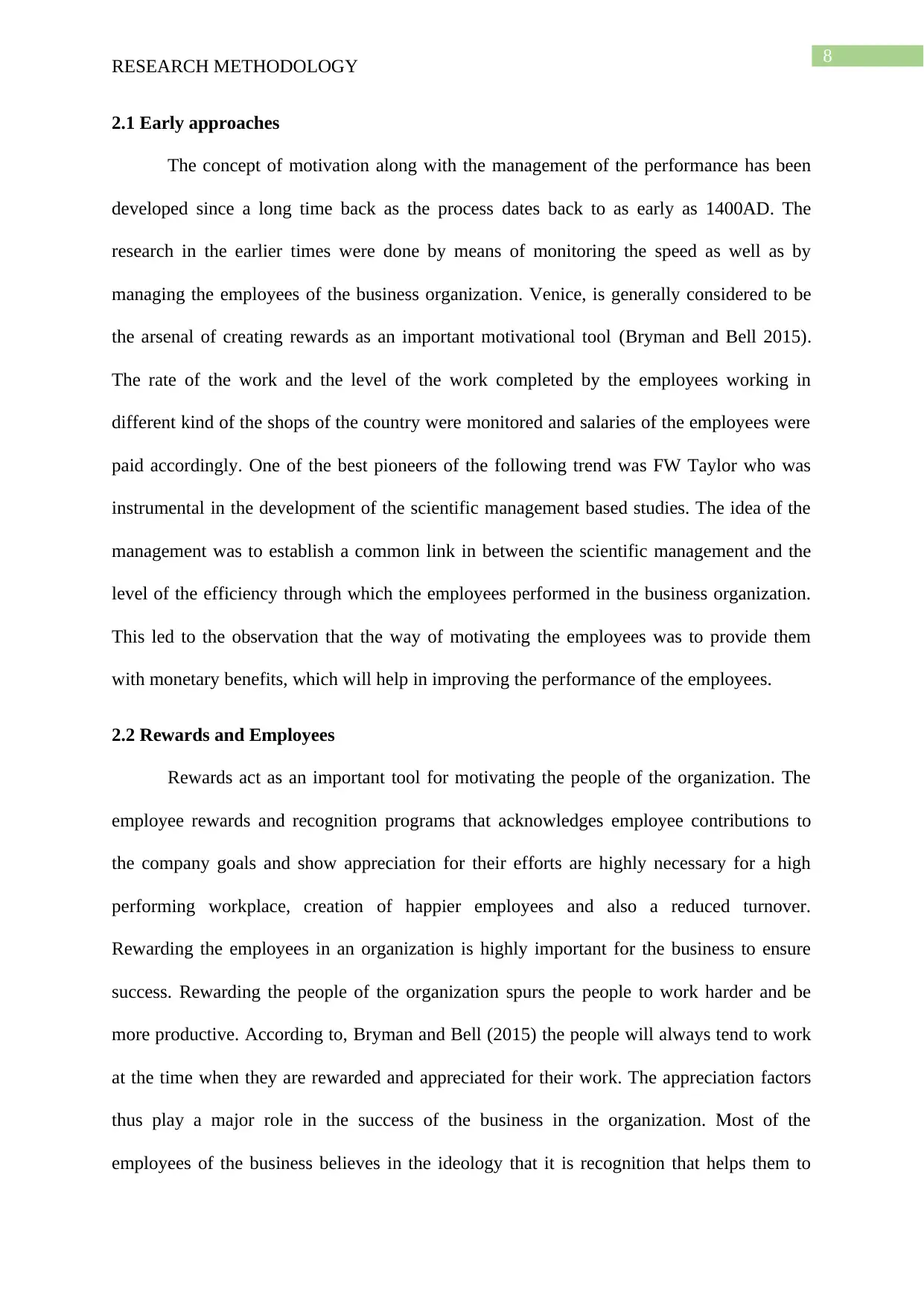
8
RESEARCH METHODOLOGY
2.1 Early approaches
The concept of motivation along with the management of the performance has been
developed since a long time back as the process dates back to as early as 1400AD. The
research in the earlier times were done by means of monitoring the speed as well as by
managing the employees of the business organization. Venice, is generally considered to be
the arsenal of creating rewards as an important motivational tool (Bryman and Bell 2015).
The rate of the work and the level of the work completed by the employees working in
different kind of the shops of the country were monitored and salaries of the employees were
paid accordingly. One of the best pioneers of the following trend was FW Taylor who was
instrumental in the development of the scientific management based studies. The idea of the
management was to establish a common link in between the scientific management and the
level of the efficiency through which the employees performed in the business organization.
This led to the observation that the way of motivating the employees was to provide them
with monetary benefits, which will help in improving the performance of the employees.
2.2 Rewards and Employees
Rewards act as an important tool for motivating the people of the organization. The
employee rewards and recognition programs that acknowledges employee contributions to
the company goals and show appreciation for their efforts are highly necessary for a high
performing workplace, creation of happier employees and also a reduced turnover.
Rewarding the employees in an organization is highly important for the business to ensure
success. Rewarding the people of the organization spurs the people to work harder and be
more productive. According to, Bryman and Bell (2015) the people will always tend to work
at the time when they are rewarded and appreciated for their work. The appreciation factors
thus play a major role in the success of the business in the organization. Most of the
employees of the business believes in the ideology that it is recognition that helps them to
RESEARCH METHODOLOGY
2.1 Early approaches
The concept of motivation along with the management of the performance has been
developed since a long time back as the process dates back to as early as 1400AD. The
research in the earlier times were done by means of monitoring the speed as well as by
managing the employees of the business organization. Venice, is generally considered to be
the arsenal of creating rewards as an important motivational tool (Bryman and Bell 2015).
The rate of the work and the level of the work completed by the employees working in
different kind of the shops of the country were monitored and salaries of the employees were
paid accordingly. One of the best pioneers of the following trend was FW Taylor who was
instrumental in the development of the scientific management based studies. The idea of the
management was to establish a common link in between the scientific management and the
level of the efficiency through which the employees performed in the business organization.
This led to the observation that the way of motivating the employees was to provide them
with monetary benefits, which will help in improving the performance of the employees.
2.2 Rewards and Employees
Rewards act as an important tool for motivating the people of the organization. The
employee rewards and recognition programs that acknowledges employee contributions to
the company goals and show appreciation for their efforts are highly necessary for a high
performing workplace, creation of happier employees and also a reduced turnover.
Rewarding the employees in an organization is highly important for the business to ensure
success. Rewarding the people of the organization spurs the people to work harder and be
more productive. According to, Bryman and Bell (2015) the people will always tend to work
at the time when they are rewarded and appreciated for their work. The appreciation factors
thus play a major role in the success of the business in the organization. Most of the
employees of the business believes in the ideology that it is recognition that helps them to
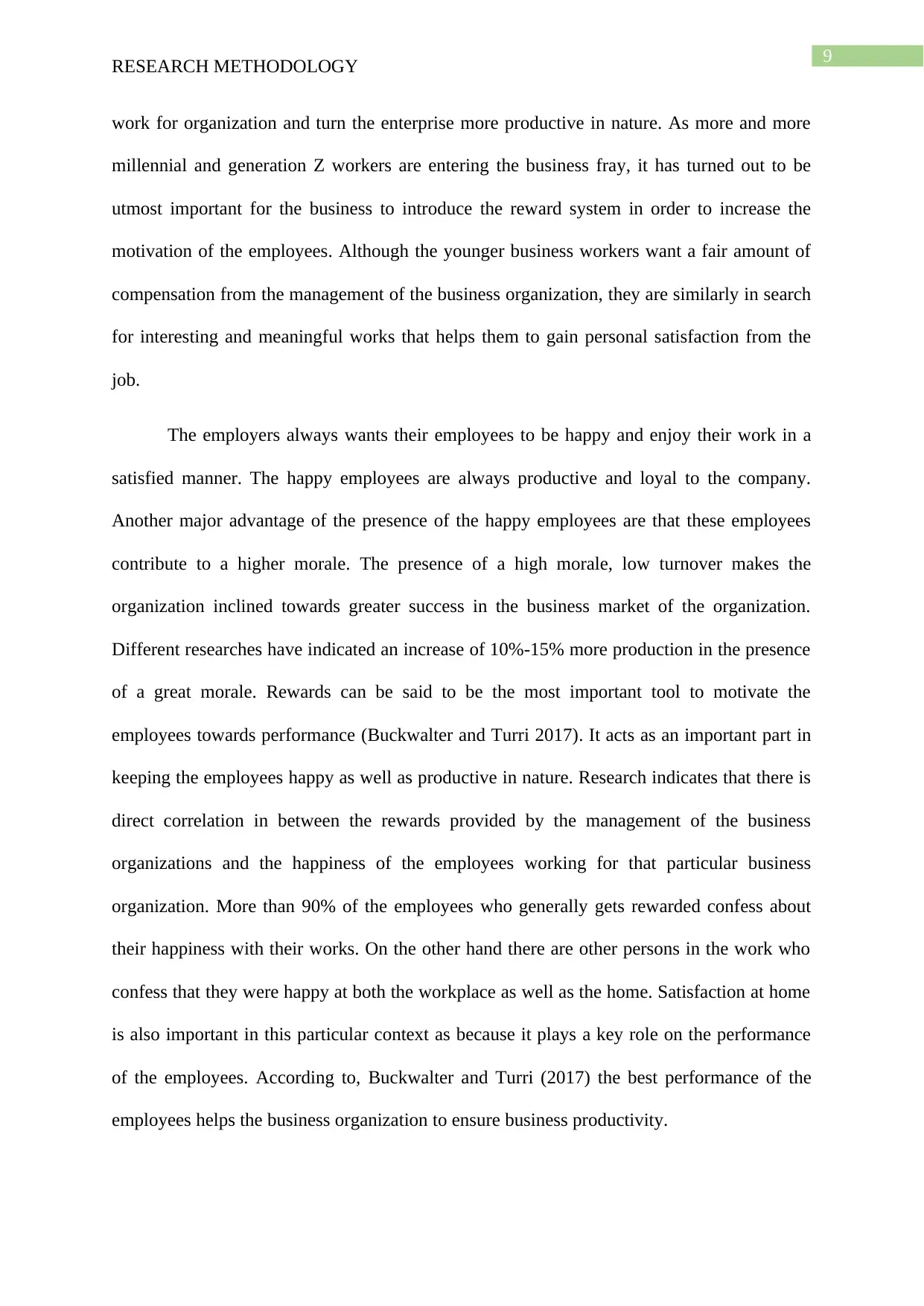
9
RESEARCH METHODOLOGY
work for organization and turn the enterprise more productive in nature. As more and more
millennial and generation Z workers are entering the business fray, it has turned out to be
utmost important for the business to introduce the reward system in order to increase the
motivation of the employees. Although the younger business workers want a fair amount of
compensation from the management of the business organization, they are similarly in search
for interesting and meaningful works that helps them to gain personal satisfaction from the
job.
The employers always wants their employees to be happy and enjoy their work in a
satisfied manner. The happy employees are always productive and loyal to the company.
Another major advantage of the presence of the happy employees are that these employees
contribute to a higher morale. The presence of a high morale, low turnover makes the
organization inclined towards greater success in the business market of the organization.
Different researches have indicated an increase of 10%-15% more production in the presence
of a great morale. Rewards can be said to be the most important tool to motivate the
employees towards performance (Buckwalter and Turri 2017). It acts as an important part in
keeping the employees happy as well as productive in nature. Research indicates that there is
direct correlation in between the rewards provided by the management of the business
organizations and the happiness of the employees working for that particular business
organization. More than 90% of the employees who generally gets rewarded confess about
their happiness with their works. On the other hand there are other persons in the work who
confess that they were happy at both the workplace as well as the home. Satisfaction at home
is also important in this particular context as because it plays a key role on the performance
of the employees. According to, Buckwalter and Turri (2017) the best performance of the
employees helps the business organization to ensure business productivity.
RESEARCH METHODOLOGY
work for organization and turn the enterprise more productive in nature. As more and more
millennial and generation Z workers are entering the business fray, it has turned out to be
utmost important for the business to introduce the reward system in order to increase the
motivation of the employees. Although the younger business workers want a fair amount of
compensation from the management of the business organization, they are similarly in search
for interesting and meaningful works that helps them to gain personal satisfaction from the
job.
The employers always wants their employees to be happy and enjoy their work in a
satisfied manner. The happy employees are always productive and loyal to the company.
Another major advantage of the presence of the happy employees are that these employees
contribute to a higher morale. The presence of a high morale, low turnover makes the
organization inclined towards greater success in the business market of the organization.
Different researches have indicated an increase of 10%-15% more production in the presence
of a great morale. Rewards can be said to be the most important tool to motivate the
employees towards performance (Buckwalter and Turri 2017). It acts as an important part in
keeping the employees happy as well as productive in nature. Research indicates that there is
direct correlation in between the rewards provided by the management of the business
organizations and the happiness of the employees working for that particular business
organization. More than 90% of the employees who generally gets rewarded confess about
their happiness with their works. On the other hand there are other persons in the work who
confess that they were happy at both the workplace as well as the home. Satisfaction at home
is also important in this particular context as because it plays a key role on the performance
of the employees. According to, Buckwalter and Turri (2017) the best performance of the
employees helps the business organization to ensure business productivity.
⊘ This is a preview!⊘
Do you want full access?
Subscribe today to unlock all pages.

Trusted by 1+ million students worldwide
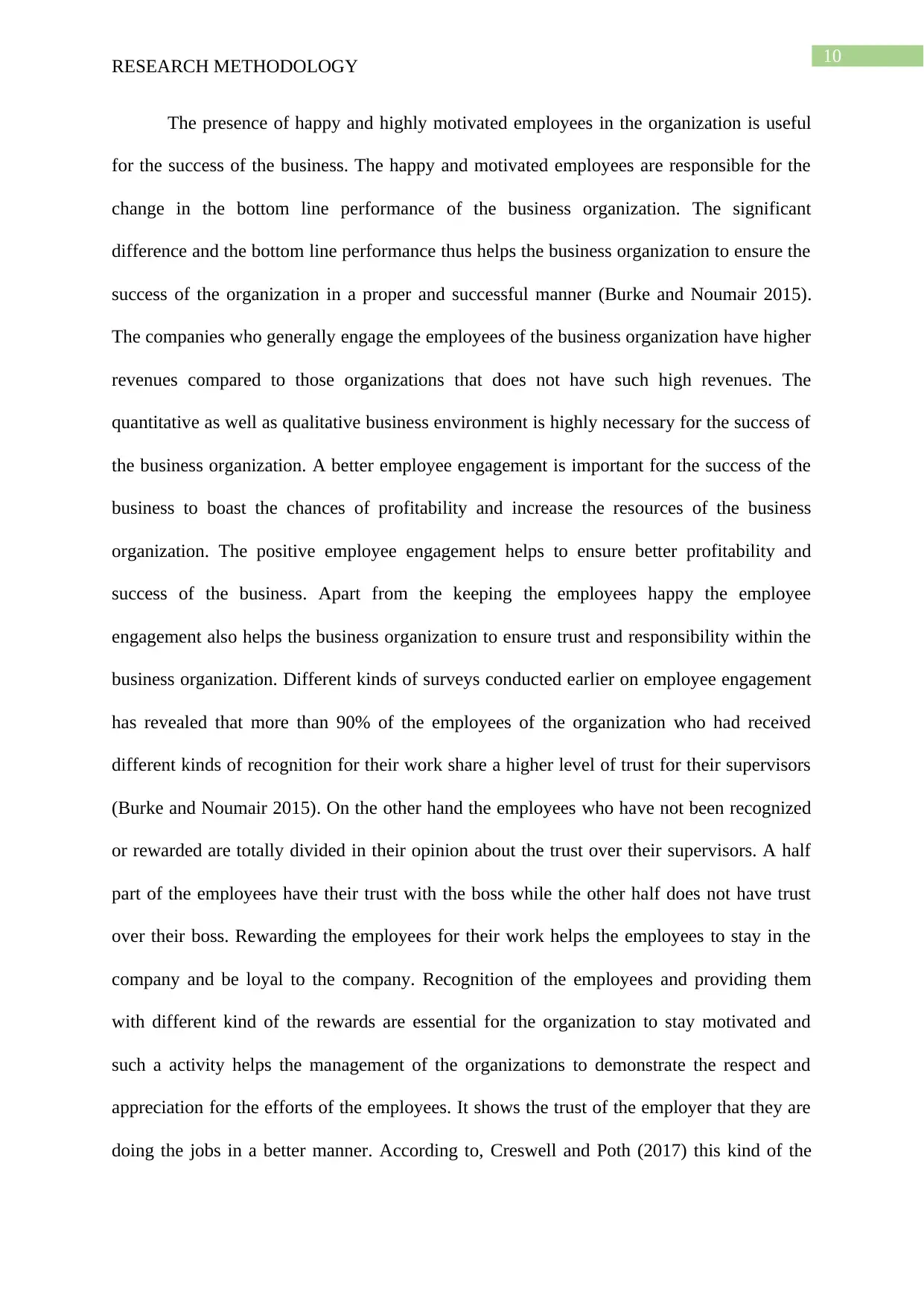
10
RESEARCH METHODOLOGY
The presence of happy and highly motivated employees in the organization is useful
for the success of the business. The happy and motivated employees are responsible for the
change in the bottom line performance of the business organization. The significant
difference and the bottom line performance thus helps the business organization to ensure the
success of the organization in a proper and successful manner (Burke and Noumair 2015).
The companies who generally engage the employees of the business organization have higher
revenues compared to those organizations that does not have such high revenues. The
quantitative as well as qualitative business environment is highly necessary for the success of
the business organization. A better employee engagement is important for the success of the
business to boast the chances of profitability and increase the resources of the business
organization. The positive employee engagement helps to ensure better profitability and
success of the business. Apart from the keeping the employees happy the employee
engagement also helps the business organization to ensure trust and responsibility within the
business organization. Different kinds of surveys conducted earlier on employee engagement
has revealed that more than 90% of the employees of the organization who had received
different kinds of recognition for their work share a higher level of trust for their supervisors
(Burke and Noumair 2015). On the other hand the employees who have not been recognized
or rewarded are totally divided in their opinion about the trust over their supervisors. A half
part of the employees have their trust with the boss while the other half does not have trust
over their boss. Rewarding the employees for their work helps the employees to stay in the
company and be loyal to the company. Recognition of the employees and providing them
with different kind of the rewards are essential for the organization to stay motivated and
such a activity helps the management of the organizations to demonstrate the respect and
appreciation for the efforts of the employees. It shows the trust of the employer that they are
doing the jobs in a better manner. According to, Creswell and Poth (2017) this kind of the
RESEARCH METHODOLOGY
The presence of happy and highly motivated employees in the organization is useful
for the success of the business. The happy and motivated employees are responsible for the
change in the bottom line performance of the business organization. The significant
difference and the bottom line performance thus helps the business organization to ensure the
success of the organization in a proper and successful manner (Burke and Noumair 2015).
The companies who generally engage the employees of the business organization have higher
revenues compared to those organizations that does not have such high revenues. The
quantitative as well as qualitative business environment is highly necessary for the success of
the business organization. A better employee engagement is important for the success of the
business to boast the chances of profitability and increase the resources of the business
organization. The positive employee engagement helps to ensure better profitability and
success of the business. Apart from the keeping the employees happy the employee
engagement also helps the business organization to ensure trust and responsibility within the
business organization. Different kinds of surveys conducted earlier on employee engagement
has revealed that more than 90% of the employees of the organization who had received
different kinds of recognition for their work share a higher level of trust for their supervisors
(Burke and Noumair 2015). On the other hand the employees who have not been recognized
or rewarded are totally divided in their opinion about the trust over their supervisors. A half
part of the employees have their trust with the boss while the other half does not have trust
over their boss. Rewarding the employees for their work helps the employees to stay in the
company and be loyal to the company. Recognition of the employees and providing them
with different kind of the rewards are essential for the organization to stay motivated and
such a activity helps the management of the organizations to demonstrate the respect and
appreciation for the efforts of the employees. It shows the trust of the employer that they are
doing the jobs in a better manner. According to, Creswell and Poth (2017) this kind of the
Paraphrase This Document
Need a fresh take? Get an instant paraphrase of this document with our AI Paraphraser
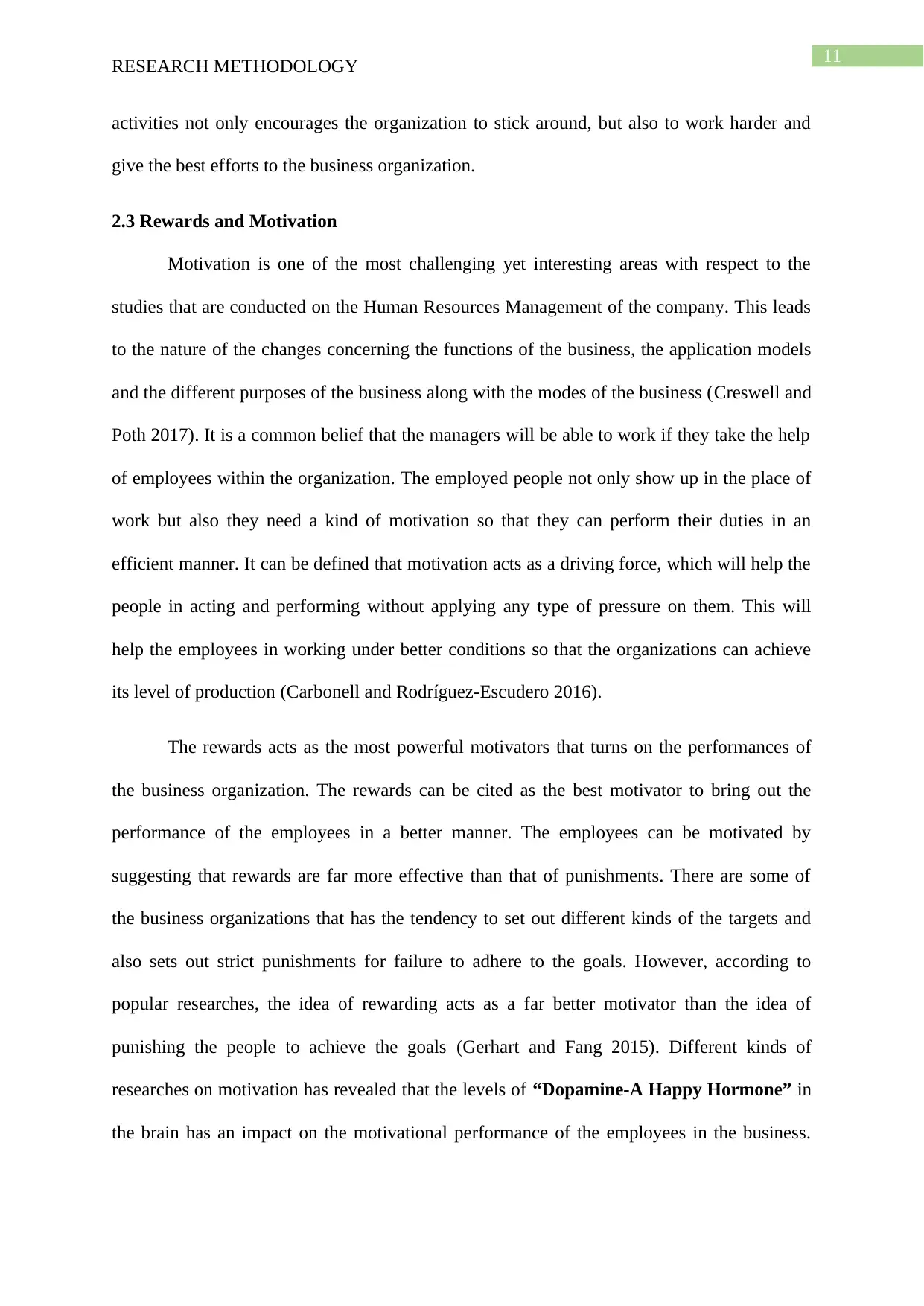
11
RESEARCH METHODOLOGY
activities not only encourages the organization to stick around, but also to work harder and
give the best efforts to the business organization.
2.3 Rewards and Motivation
Motivation is one of the most challenging yet interesting areas with respect to the
studies that are conducted on the Human Resources Management of the company. This leads
to the nature of the changes concerning the functions of the business, the application models
and the different purposes of the business along with the modes of the business (Creswell and
Poth 2017). It is a common belief that the managers will be able to work if they take the help
of employees within the organization. The employed people not only show up in the place of
work but also they need a kind of motivation so that they can perform their duties in an
efficient manner. It can be defined that motivation acts as a driving force, which will help the
people in acting and performing without applying any type of pressure on them. This will
help the employees in working under better conditions so that the organizations can achieve
its level of production (Carbonell and Rodríguez-Escudero 2016).
The rewards acts as the most powerful motivators that turns on the performances of
the business organization. The rewards can be cited as the best motivator to bring out the
performance of the employees in a better manner. The employees can be motivated by
suggesting that rewards are far more effective than that of punishments. There are some of
the business organizations that has the tendency to set out different kinds of the targets and
also sets out strict punishments for failure to adhere to the goals. However, according to
popular researches, the idea of rewarding acts as a far better motivator than the idea of
punishing the people to achieve the goals (Gerhart and Fang 2015). Different kinds of
researches on motivation has revealed that the levels of “Dopamine-A Happy Hormone” in
the brain has an impact on the motivational performance of the employees in the business.
RESEARCH METHODOLOGY
activities not only encourages the organization to stick around, but also to work harder and
give the best efforts to the business organization.
2.3 Rewards and Motivation
Motivation is one of the most challenging yet interesting areas with respect to the
studies that are conducted on the Human Resources Management of the company. This leads
to the nature of the changes concerning the functions of the business, the application models
and the different purposes of the business along with the modes of the business (Creswell and
Poth 2017). It is a common belief that the managers will be able to work if they take the help
of employees within the organization. The employed people not only show up in the place of
work but also they need a kind of motivation so that they can perform their duties in an
efficient manner. It can be defined that motivation acts as a driving force, which will help the
people in acting and performing without applying any type of pressure on them. This will
help the employees in working under better conditions so that the organizations can achieve
its level of production (Carbonell and Rodríguez-Escudero 2016).
The rewards acts as the most powerful motivators that turns on the performances of
the business organization. The rewards can be cited as the best motivator to bring out the
performance of the employees in a better manner. The employees can be motivated by
suggesting that rewards are far more effective than that of punishments. There are some of
the business organizations that has the tendency to set out different kinds of the targets and
also sets out strict punishments for failure to adhere to the goals. However, according to
popular researches, the idea of rewarding acts as a far better motivator than the idea of
punishing the people to achieve the goals (Gerhart and Fang 2015). Different kinds of
researches on motivation has revealed that the levels of “Dopamine-A Happy Hormone” in
the brain has an impact on the motivational performance of the employees in the business.
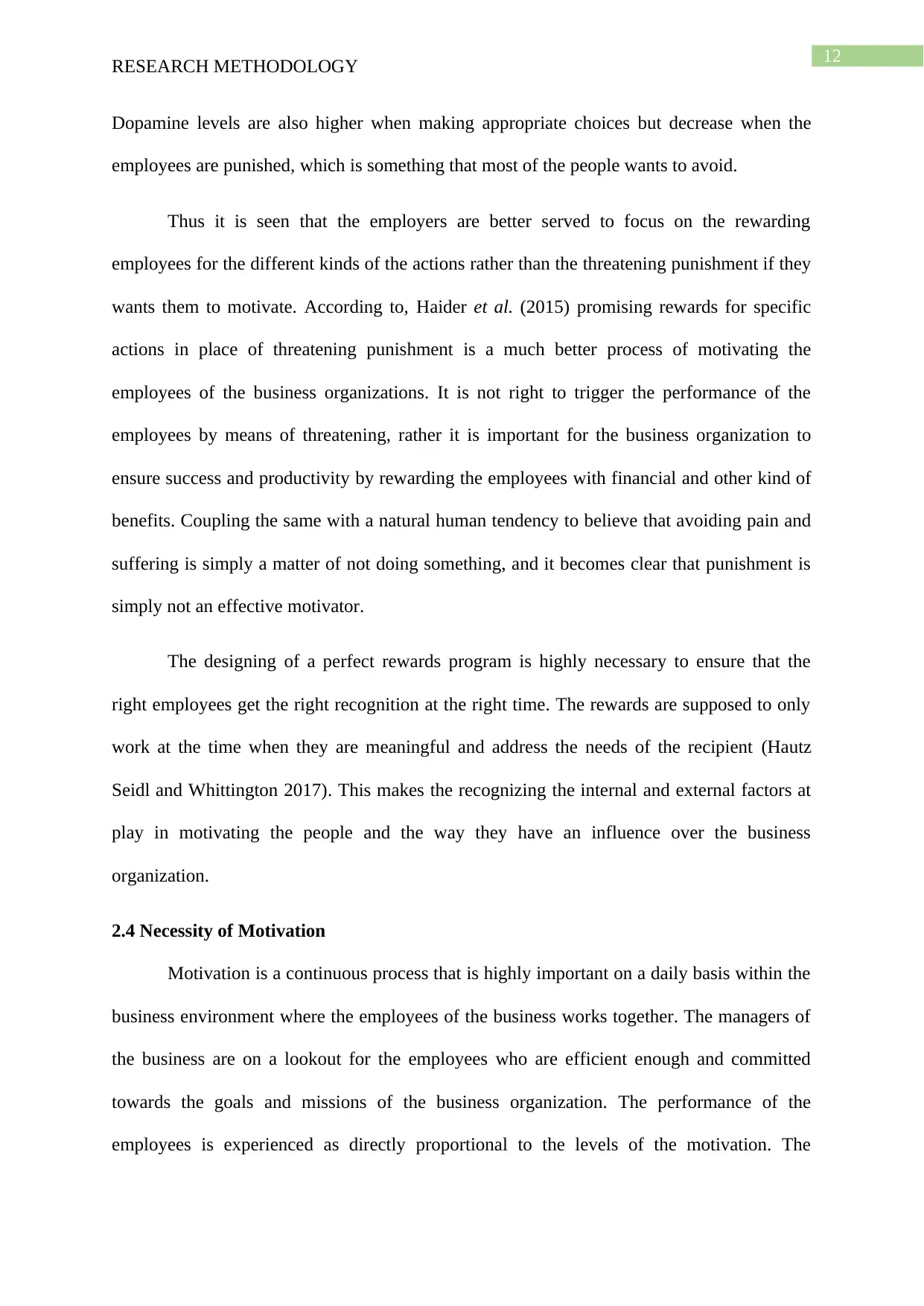
12
RESEARCH METHODOLOGY
Dopamine levels are also higher when making appropriate choices but decrease when the
employees are punished, which is something that most of the people wants to avoid.
Thus it is seen that the employers are better served to focus on the rewarding
employees for the different kinds of the actions rather than the threatening punishment if they
wants them to motivate. According to, Haider et al. (2015) promising rewards for specific
actions in place of threatening punishment is a much better process of motivating the
employees of the business organizations. It is not right to trigger the performance of the
employees by means of threatening, rather it is important for the business organization to
ensure success and productivity by rewarding the employees with financial and other kind of
benefits. Coupling the same with a natural human tendency to believe that avoiding pain and
suffering is simply a matter of not doing something, and it becomes clear that punishment is
simply not an effective motivator.
The designing of a perfect rewards program is highly necessary to ensure that the
right employees get the right recognition at the right time. The rewards are supposed to only
work at the time when they are meaningful and address the needs of the recipient (Hautz
Seidl and Whittington 2017). This makes the recognizing the internal and external factors at
play in motivating the people and the way they have an influence over the business
organization.
2.4 Necessity of Motivation
Motivation is a continuous process that is highly important on a daily basis within the
business environment where the employees of the business works together. The managers of
the business are on a lookout for the employees who are efficient enough and committed
towards the goals and missions of the business organization. The performance of the
employees is experienced as directly proportional to the levels of the motivation. The
RESEARCH METHODOLOGY
Dopamine levels are also higher when making appropriate choices but decrease when the
employees are punished, which is something that most of the people wants to avoid.
Thus it is seen that the employers are better served to focus on the rewarding
employees for the different kinds of the actions rather than the threatening punishment if they
wants them to motivate. According to, Haider et al. (2015) promising rewards for specific
actions in place of threatening punishment is a much better process of motivating the
employees of the business organizations. It is not right to trigger the performance of the
employees by means of threatening, rather it is important for the business organization to
ensure success and productivity by rewarding the employees with financial and other kind of
benefits. Coupling the same with a natural human tendency to believe that avoiding pain and
suffering is simply a matter of not doing something, and it becomes clear that punishment is
simply not an effective motivator.
The designing of a perfect rewards program is highly necessary to ensure that the
right employees get the right recognition at the right time. The rewards are supposed to only
work at the time when they are meaningful and address the needs of the recipient (Hautz
Seidl and Whittington 2017). This makes the recognizing the internal and external factors at
play in motivating the people and the way they have an influence over the business
organization.
2.4 Necessity of Motivation
Motivation is a continuous process that is highly important on a daily basis within the
business environment where the employees of the business works together. The managers of
the business are on a lookout for the employees who are efficient enough and committed
towards the goals and missions of the business organization. The performance of the
employees is experienced as directly proportional to the levels of the motivation. The
⊘ This is a preview!⊘
Do you want full access?
Subscribe today to unlock all pages.

Trusted by 1+ million students worldwide
1 out of 30
Related Documents
Your All-in-One AI-Powered Toolkit for Academic Success.
+13062052269
info@desklib.com
Available 24*7 on WhatsApp / Email
![[object Object]](/_next/static/media/star-bottom.7253800d.svg)
Unlock your academic potential
Copyright © 2020–2025 A2Z Services. All Rights Reserved. Developed and managed by ZUCOL.





